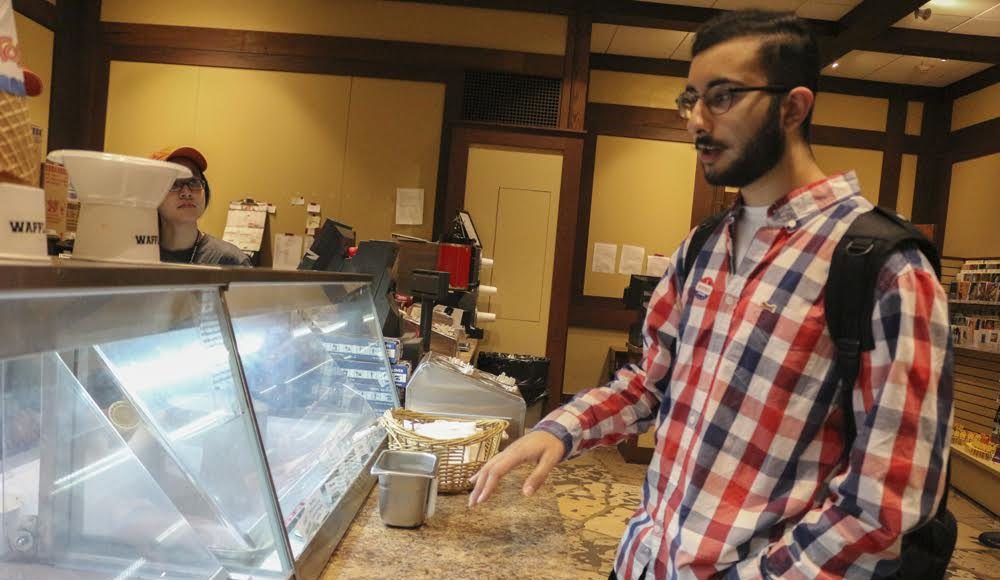 Ali Khan, a Muslim sophomore at UW-Madison, has always wanted to feel as much like a Badger as he could. He loves being involved in the campus community, loves meeting new faces everyday, and (of course) wears red on game days. But when he goes into Memorial Union, Union South, or any other campus facility that sells that iconic Babcock ice cream, he feels out of place. Because Babcock contains pork gelatin, he can’t have it due to religious dietary restrictions. Khan, and many other Badgers, face the same separation from the rest of the Badgers on campus.
Ali Khan, a Muslim sophomore at UW-Madison, has always wanted to feel as much like a Badger as he could. He loves being involved in the campus community, loves meeting new faces everyday, and (of course) wears red on game days. But when he goes into Memorial Union, Union South, or any other campus facility that sells that iconic Babcock ice cream, he feels out of place. Because Babcock contains pork gelatin, he can’t have it due to religious dietary restrictions. Khan, and many other Badgers, face the same separation from the rest of the Badgers on campus.
The Equity and Inclusion Committee (EIC), as part of the Associated Students of Madison (ASM), is looking to eradicate the use of pork gelatin from all flavors of Babcock ice cream. The EIC is dedicated to working on campaigns that relate to social justice issue, as well as diversity. Khan, chairman of EIC, states “right now, Babcock is seen as a symbol of Wisconsin, the dairy state, and it’s manufactured mainly on campus, meaning that the ice cream here is a really vital part to the Wisconsin experience, according to the university. A lot of Badgers can’t enjoy the ice cream due to dietary or religious restrictions, and it shouldn’t be that way.” To Khan, this issue is about more than just ice cream, it’s about inclusion on campus. Last semester, Khan, a new intern for EIC decided to investigate the use of pork gelatin in the ice cream, and shed light on it.
As a Madison native, Khan was always aware that he should not eat Babcock ice cream, and whenever he was in an area where Babcock ice cream was sold, he was unable to have the same experience others were. “Currently, Muslim, Hindu, Jewish, Buddhist, and Vegetarian Badgers are unable to enjoy the ice cream that the rest of the school and state have so much pride in” Khan said.
This semester, he is working in collaboration with ASM and the Union Dining Services in order to put more pressure on Babcock and its providers to change the recipe. One of the very first things to do, however, is to let the general public know. There is a massive lack of knowledge about what is in the ice cream, and allowing people to know what they’re eating is the first step to elicit change. There is a sign that states the ice cream contains pork gelatin, and there are actually flavors that do not contain pork gelatin, called the super premium flavors, but those flavors rank as least popular among most customers, and the options available are vastly limited. While it’s nice that there is a sign, there can be more. If a student who can’t eat pork gelatin wants ice cream, instead of coming to a campus facility, the student has to travel off campus in order to get it. Economically, it is more fruitful for Babcock to remove pork gelatin in order to bring more customers that would otherwise be inaccessible.
There is no need for pork gelatin to be in the ice cream; in fact, most ice cream companies do not use pork gelatin. As an alternative, the manufacturers can use vegetarian stabilizers such as Carrageenan. Using pork gelatin is a slower process, costs twice the amount of a vegetarian stabilizer, and is reminiscent of what UW-Madison was like when it first opened: a white, Christian campus.
Khan stated that when he talked to supporters of the current recipe, one of them claimed that using the gelatin was tradition, and the need for alumni to taste the same ice cream they had when they were students is essential. But, Khan says, it is time for tradition to change — and vegetarian stabilizers do not change the taste of the ice cream anyway.
Khan and Carmen Goséy, chair of the Student Council on ASM, met with the Union Dining Assistant Director Carl Korz and student leader for the Dining Services Committee Caleb Foust on November 3. Goséy said ASM’s main goal was to completely phase out pork gelatin because it “marginalizes students, which is something we are working against.” While Foust and Korz agreed, they concluded that there was a need for incremental target goals, and that their support would mean a lot to Babcock, enough for people to listen. For now, this is one of the few things the Dining Services can do, since Babcock ice cream makes up to about 55% of their revenue, which goes back into student programs such as the Wisconsin Union Directory (WUD), and the organizations under that. Khan said that Bill Klein, Dairy Plant Manager, was open to a change in the recipe to remove pork gelatin, and there was talk of setting up an in person survey, where students would taste both versions of ice cream and pick which one they liked.
While that may be a step in the right direction, there is a long way to go in the movement for full inclusion. Khan, Goséy, and other members of the campus community deserve to feel as much of a Badger as everyone else.
This story was reported and written by a student reporter in the Madison365 Academy program. To learn more or support the Madison365 Academy visit madison365.org/academy.
.


































